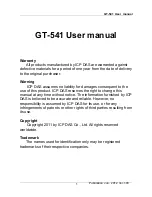
831
Glossary
intranet
A private network that serves users of an enterprise. Although intranet pages may link to the
Internet, an intranet is not a network that is accessed by the general public.
intrusion detection
A security service that monitors and analyzes system events for the purpose of finding and providing
real-time, or near real-time, warning of attempts to access system resources in an unauthorized
manner.
intrusion event
A significant security occurrence that appears to exploit a vulnerability of the system or application.
Intrusion events contain detailed information about possible attacks.
intrusion management
The centralized management of intrusion-based security technologies to identify, manage, and
mitigate network intrusions based on security policy.
intrusion prevention
The analysis and rejection of packets that match known attack types.
IP (Internet Protocol)
The method or protocol by which data is sent from one computer to another on the Internet. Each
computer (known as a host) on the Internet has at least one address that uniquely identifies it to all
other computers on the Internet.
IP address
A unique number that identifies a workstation on a TCP/IP network and specifies routing
information. Each workstation on a network must be assigned a unique IP address, which consists of
the network ID, plus a unique host ID assigned by the network administrator. This address is usually
represented in dot-decimal notation, with the decimal values separated by a period (for example
123.45.6.24).
IP hijacking
An attack in which an active, established session is intercepted and taken over by the attacker. This
attack may take place after authentication has occurred, which allows the attacker to assume the role
of an already authorized user.
IP number
A unique number (also called a dotted quad) consisting of 4 parts separated by dots (for example,
199.171.33.46). Every computer on the Internet has a unique IP number. If a computer does not have
an IP number, it is not really on the Internet. Most computers also have one or more domain names
that are easier for people to remember.
IP sniffing
The stealing of network addresses by reading the packets. Harmful data is then sent stamped with
internal trusted addresses.
IP spoofing
An attack in which someone intercepts and co-opts an active, established session. IP spoofing is also
an attack method by which IP packets are sent with a false source address, which may try to
circumvent firewalls by adopting the IP address of a trusted source. This fools the firewall into
thinking that the packets from the hacker are actually from a trusted source. IP spoofing can also be
used simply to hide the true origin of an attack.
IPSec (Internet Protocol Security)
A developing standard for security at the network or packet-processing layer of network
communication. IPSec provides two choices of security service: Authentication Header (AH), which
essentially allows authentication of the sender of data, and Encapsulating Security Payload (ESP),
which supports both the authentication of the sender and encryption of data as well. IPSec is widely
used with virtual private networks.
ISP (Internet service provider)
An organization or company that provides dial-up or other access to the Internet, usually for money.
Java
A programming language expressly designed for use in the distributed environment of the Internet.
It was designed to have the look and feel of the C++ language, but it is simpler to use than C++ and
enforces a completely object-oriented view of programming. Java can be used to create complete
applications that can run on a single computer or be distributed among servers and clients in a
network. It can also be used to build small application modules or applets for use as part of a Web
page. Applets make it possible for a Web page user to interact with the page.
Java applet
A program designed to be executed from within another application. Unlike an application, applets
cannot be executed directly from the operating system.
JRE (Java Runtime Environment)
A library of routines that let you use Java applets. With the JRE installed, Java applets can be
downloaded from a Web server and run on your computer by a Java-compatible Web browser, such as
Netscape Navigator or Microsoft Internet Explorer.
Summary of Contents for Security 5600 Series, Security 5400 Series,Clientless VPN 4400 Series
Page 76: ...76 Managing administrative access Enabling SSH for command line access to the appliance...
Page 242: ...242 Defining your security environment Controlling full application inspection of traffic...
Page 243: ...243 Defining your security environment Controlling full application inspection of traffic...
Page 269: ...268 Limiting user access Authenticating using Out Of Band Authentication OOBA...
Page 373: ...372 Preventing attacks Enabling protection for logical network interfaces...
Page 509: ...508 Generating reports Upgrade reports...
Page 553: ...552 Advanced system settings Configuring advanced options...
Page 557: ...556 SSL server certificate management Installing a signed certificate...
Page 861: ...860 Index...
















































